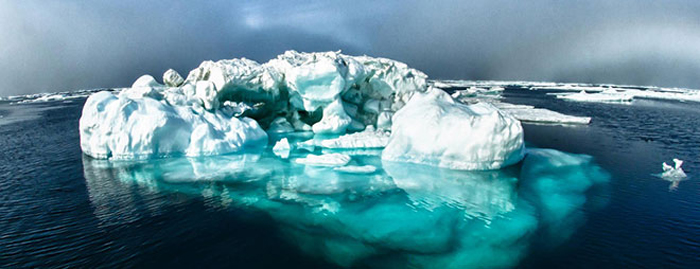Underwater Microphones Eavesdrop On Icebergs

(ISNS) – Icebergs are loud travelers, and underwater microphones listening in on nuclear tests can hear them. The acoustic arrays, designed to pick up minute sounds thousands of miles away, can overhear other ocean noise too: ships, marine life and icebergs.
In the process, two microphone arrays off the coast of Australia tracked the sounds of two icebergs as they cracked, collided and "screamed" their way along an Antarctic glacier.
Scientists know these icy behemoths well. Approximately 40-50 kilometers in diameter, they have been drifting for nearly ten years. Scientists usually track such icebergs with satellites, but new data published in the journal Geophysical Research Letters shows that hydroacoustic signals can also pinpoint their location. The acoustic signals could also identify icebergs when they grew too small for satellites to monitor.
The oceanic microphones that picked up these sounds aren't there for icebergs. Part of the International Monitoring System, they were placed across the southern Indian Ocean to track nuclear explosions as part of the Comprehensive Nuclear Test Ban treaty.
Gathering hundreds of days' worth of data from two of the system's hydrophone arrays, the researchers, based in the Netherlands and Australia, localized the positions of two strong sound sources.
Since the two arrays were nearly 5000 km apart, the signals were unlikely to be from weaker sources like ships or marine life. Satellite measurements confirmed their acoustic data: the sounds were those of two large icebergs falling apart.
"The unique thing about icebergs like this is that they are so large you can see them on two systems thousands of kilometers apart," said Laslo Evers, lead author on the study and researcher at KNMI, the Royal Netherlands Meteorological Institute.
Sign up for the Live Science daily newsletter now
Get the world’s most fascinating discoveries delivered straight to your inbox.
"I was quite amazed by these enormous ranges - over thousands of kilometers, you could see an iceberg breaking up or smaller pieces rubbing against each other," he added.
Satellite monitoring – currently the primary method used to track floating ice – can be difficult in dark or overcast skies. Acoustic signals could supplement satellite tracking in such situations, Evers said.
Many previous studies of iceberg activity have focused on the Antarctic coast, but this is among the first to observe their movements in the open ocean.
"This is a very comprehensive dataset of iceberg tracks confirmed with satellite information," said Emile Okal, a geophysicist at Northwestern University in Evanston, Ill., who was not involved with the new study. "They show that you can systematically follow icebergs using acoustic signals and build extensive databases to complement remote sensing data."
Earlier work from Okal's group has zoomed in to the spectrum of sounds drifting ice makes. The group deployed seismometers on icebergs to identify how melting or movement made specific noises.
"You could think of it as the iceberg talking or singing and you can look at the nature of the music," said Okal. "You can pass this music into a spectral detector to see if it plays the bass or the treble, if it has a preference for a particular key or frequency."
The spectral analysis revealed iceberg sounds were most often from chunks of ice rubbing up against each other. Understanding the physical processes that generate iceberg sounds is different from monitoring populations of icebergs as they move, which was the focus of the new study from Evers' group.
Data from the International Monitoring System's hydrophone arrays revealed a similar origin for the sounds. Acoustic signals were more frequent when icebergs broke up, the researchers found. Smaller chunks formed from the break-up also sent out sound signals that the arrays picked up.
In future work, Evers' group hopes to learn how much an iceberg can shrink before it grows small enough to fall silent on the hydrophone arrays.
Knowing the background levels of ocean noise can help distinguish the sounds of icebergs from others – such as explosions or earthquakes, said Evers. Hydro-acoustic signals may also help identify signs of deep ocean warming, and changes in outlet glaciers or sea ice, according to him.
"There's an enormous amount of sound in the oceans, and we can use this sound to learn what's happening in the oceans," he said.
This story was provided by Inside Science News Service. Jyoti Madhusoodanan is a science writer based in San Jose, Calif. She tweets at @smjyoti.









